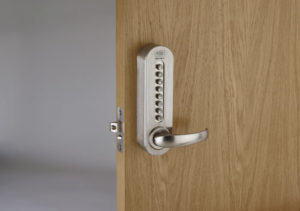It often seems that specifiers face a choice between mechanical and digital access control systems, with solutions such as mechanically operated push button locksets viewed as being inferior to their electronic counterparts. Craig Birch, Product Category Manager at UNION, explains why the latest changes to BS 8607 means new, security-focused mechanically operated push button lockets can complement digital systems, as well as help realise new sales opportunities for merchants.
Mechanically operated push button locksets are used in buildings around the world, to help manage access control at a site, as well as protect assets and people. Nevertheless, these products can sometimes be seen as the poor relation to digital access control, particularly those that are linked to a wireless network. And with a digital access control solution often seen as being more secure than a mechanically operated push button lockset, there is a real risk that many are missing out on the many benefits that a mechanical system can offer.
The latest changes to BS 8607 – the standard governing mechanically operated push button locksets – have seen the arrival of grade 5. This is the newest and most stringent level for delivering assured security and access control from mechanically operated push button locksets. But what does it offer that grade 4 – previously the highest grade for BS 8607 – does not?
Making the grade
Both grade 4 and grade 5 of BS 8607 stipulate that products meeting these standards must be suitable for ‘applications where security, abuse and usage levels are expected to be equivalent to BS 3621’, which relates to thief-resistant locks. Products for both grades 4 and 5 also undergo a General Vulnerability Assessment, using tools such as vice grips, cordless drills, picking tools, chisels and wedges. 
The difference between the two grades, then, is that devices rated grade 4 can only achieve this standard with the help of an integral additional locking unit. So with a grade 4 product, users must lock and unlock the solution from the inside with a key, and then operate the mechanically operated push button lockset from the outside to unlock the door.
In contrast, a mechanically operated push button lockset that meets grade 5 standards provides a ‘one-stop’ security and access control solution; one that does not require a separate locking unit. With a grade 5 product, the latch and lock are integrated and tested together, without the need for an additional key. This means that, when it shuts, a grade 5 solution automatically locks. Then, should a user need to exit a room, it is simply a one handle operation to unlock the door.
While it is intended that both grade 4 and 5 devices offer the same resistance to attack and it is simply the way it is locked that is different, the fact that a user has to physically lock a door themselves with a grade 4 product means the technology is reliant on key holders to secure the premises themselves. With a grade 5 solution, security is assured as the door will automatically lock.
Meeting demanding door environments
One of the key benefits to a grade 5 device is that, because they offer a far higher level of security, these products can be deployed in more demanding areas where networked digital solutions may not be suitable. For instance, doors that need securing in external perimeter boundaries are often located far from estates’ offices. This can mean monitoring and maintaining a digital device can be a challenge. In contrast, a grade 5 mechanically operated push button lockset can deliver high levels of security, with minimal maintenance.
These products are also suitable where doorway abuse is likely. For staff that needs to easily enter and exit areas, while ensuring members of the public stay on one side of the door, a grade 5 product offering keyless egress is an ideal solution. By integrating these easy-to-operate mechanical solutions with digital access control systems, it is possible to ensure site security while also meeting the challenge presented in areas open to the general public too.
Furthermore, some digital devices are also unsuitable for harsh environments, where they might be exposed to extreme temperatures, corrosive spray and airborne dust. These hazards could damage an electronic unit’s housing, potentially resulting in the device failing. In such situations, highly durable mechanically operated push-button locks can offer invaluable levels of access control and security, while also being used in tandem with an existing digital system.
Ultimately, a grade 5 product can help meet the security and access control needs of most commercial environments. This presents a real sales opportunity for merchants looking to offer solutions that balance both security and access control. Merchants have the opportunity to upsell to higher grade security solutions, increasing basket spend for customers and profit for themselves. Therefore, it is vital that merchants are aware of the latest standards, such as BS 8607, so that they can educate their customers working on commercial contracts.
It is no longer a question of mechanical versus digital – instead, the optimum solution for each access point can be selected, with both mechanical and digital working collaboratively.
UNION’s latest CodeGUARD 5 solution was the first mechanically operated push button lockset to meet the new grade 5 standards for BS 8607. The product is also accredited by Secured By Design, meeting the high standards set by the police initiative for improving the security of buildings and their immediate surroundings. For more information, visit www.uniononline.co.uk/codeguard5.
 Builders Merchants Journal – BMJ Publishing to Builders Merchants and the UK merchanting industry for more than 95 years
Builders Merchants Journal – BMJ Publishing to Builders Merchants and the UK merchanting industry for more than 95 years



